Strategic Global Outsourcing and Offshoring: IT Infrastructure Report
VerifiedAdded on 2020/03/04
|16
|4722
|34
Report
AI Summary
This report, prepared for a UK-based bank facing IT infrastructure challenges following a merger, provides strategic recommendations for global outsourcing and offshoring. The author, an outsourcing consultant, addresses the need for IT service standardization and centralization. The report analyzes various sourcing models, including Comprehensive Outsourcing, Joint Ventures, and Multi-Sourcing, evaluating their benefits and risks. It also explores supplier configurations such as Sole Supplier and Best of Breed, and outlines a supplier selection process. Furthermore, the report discusses alternative contract types, skills retention, and a four-stage model for designing IT systems and services. The final sections cover governance mechanisms and transition strategies to ensure successful outsourcing relationships. The report offers a comprehensive guide to help the bank effectively integrate IT services and optimize its operations through strategic outsourcing.

Student’s Last Name1
Strategic Global Outsourcing and Off shoring
By (Name)
Course
Professor
University
Date
Strategic Global Outsourcing and Off shoring
By (Name)
Course
Professor
University
Date
Paraphrase This Document
Need a fresh take? Get an instant paraphrase of this document with our AI Paraphraser
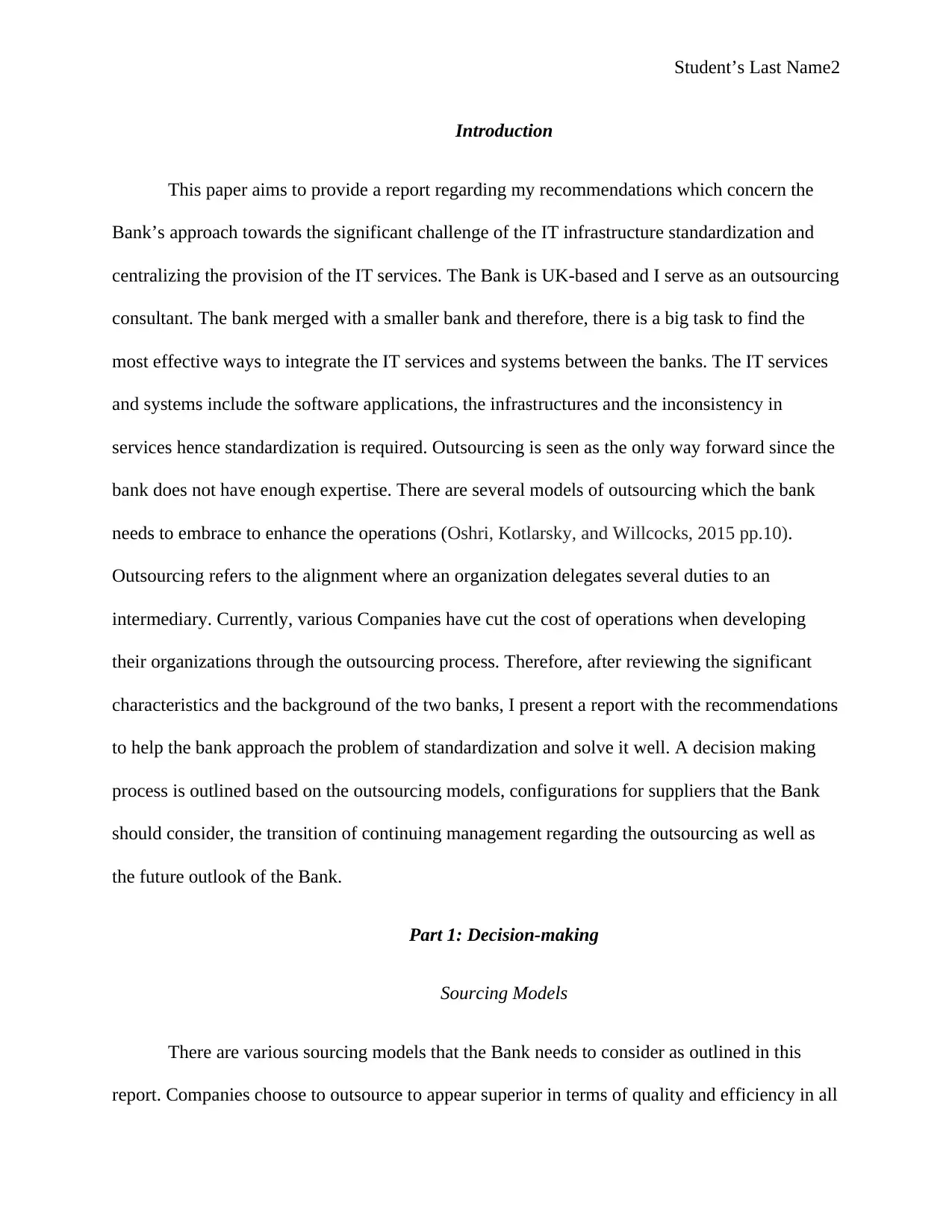
Student’s Last Name2
Introduction
This paper aims to provide a report regarding my recommendations which concern the
Bank’s approach towards the significant challenge of the IT infrastructure standardization and
centralizing the provision of the IT services. The Bank is UK-based and I serve as an outsourcing
consultant. The bank merged with a smaller bank and therefore, there is a big task to find the
most effective ways to integrate the IT services and systems between the banks. The IT services
and systems include the software applications, the infrastructures and the inconsistency in
services hence standardization is required. Outsourcing is seen as the only way forward since the
bank does not have enough expertise. There are several models of outsourcing which the bank
needs to embrace to enhance the operations (Oshri, Kotlarsky, and Willcocks, 2015 pp.10).
Outsourcing refers to the alignment where an organization delegates several duties to an
intermediary. Currently, various Companies have cut the cost of operations when developing
their organizations through the outsourcing process. Therefore, after reviewing the significant
characteristics and the background of the two banks, I present a report with the recommendations
to help the bank approach the problem of standardization and solve it well. A decision making
process is outlined based on the outsourcing models, configurations for suppliers that the Bank
should consider, the transition of continuing management regarding the outsourcing as well as
the future outlook of the Bank.
Part 1: Decision-making
Sourcing Models
There are various sourcing models that the Bank needs to consider as outlined in this
report. Companies choose to outsource to appear superior in terms of quality and efficiency in all
Introduction
This paper aims to provide a report regarding my recommendations which concern the
Bank’s approach towards the significant challenge of the IT infrastructure standardization and
centralizing the provision of the IT services. The Bank is UK-based and I serve as an outsourcing
consultant. The bank merged with a smaller bank and therefore, there is a big task to find the
most effective ways to integrate the IT services and systems between the banks. The IT services
and systems include the software applications, the infrastructures and the inconsistency in
services hence standardization is required. Outsourcing is seen as the only way forward since the
bank does not have enough expertise. There are several models of outsourcing which the bank
needs to embrace to enhance the operations (Oshri, Kotlarsky, and Willcocks, 2015 pp.10).
Outsourcing refers to the alignment where an organization delegates several duties to an
intermediary. Currently, various Companies have cut the cost of operations when developing
their organizations through the outsourcing process. Therefore, after reviewing the significant
characteristics and the background of the two banks, I present a report with the recommendations
to help the bank approach the problem of standardization and solve it well. A decision making
process is outlined based on the outsourcing models, configurations for suppliers that the Bank
should consider, the transition of continuing management regarding the outsourcing as well as
the future outlook of the Bank.
Part 1: Decision-making
Sourcing Models
There are various sourcing models that the Bank needs to consider as outlined in this
report. Companies choose to outsource to appear superior in terms of quality and efficiency in all
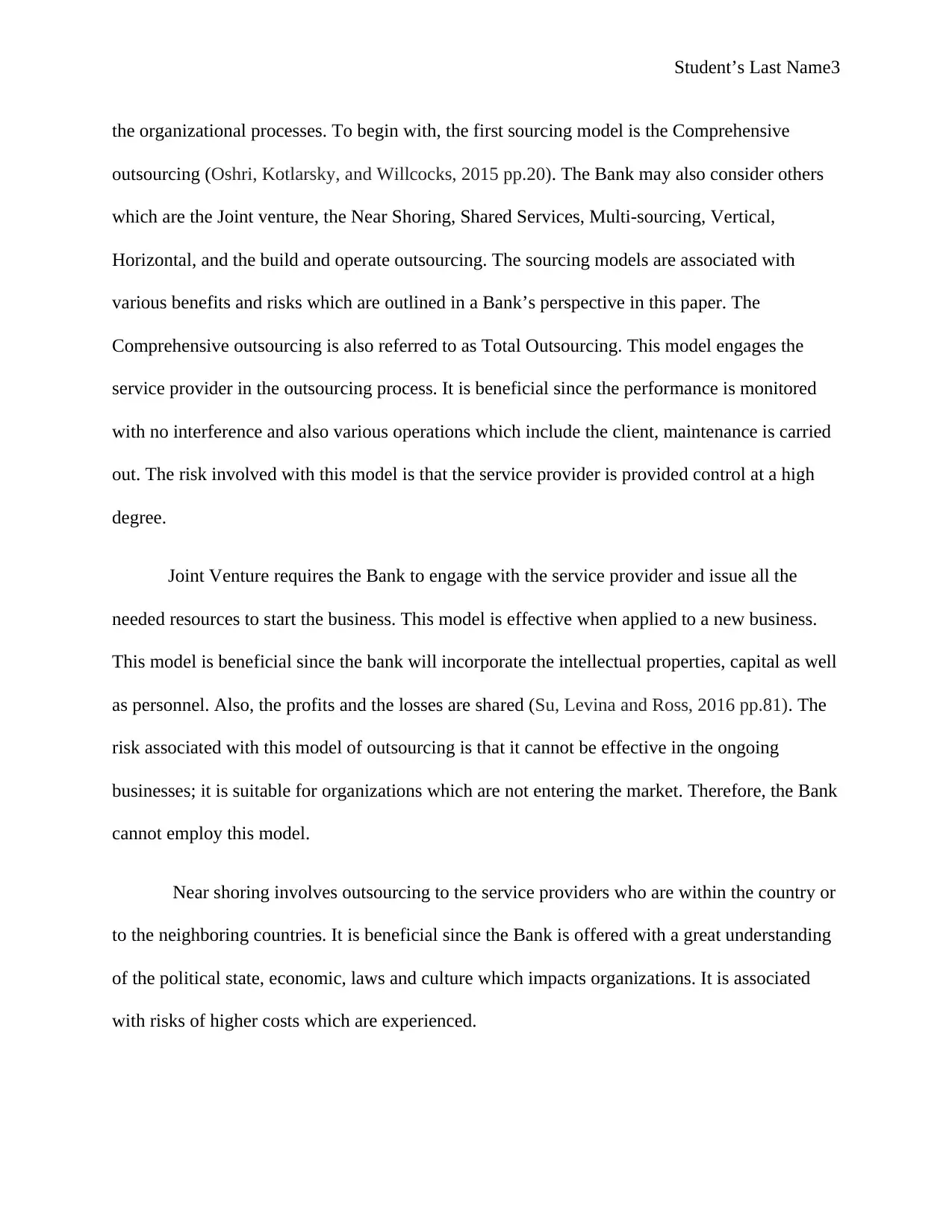
Student’s Last Name3
the organizational processes. To begin with, the first sourcing model is the Comprehensive
outsourcing (Oshri, Kotlarsky, and Willcocks, 2015 pp.20). The Bank may also consider others
which are the Joint venture, the Near Shoring, Shared Services, Multi-sourcing, Vertical,
Horizontal, and the build and operate outsourcing. The sourcing models are associated with
various benefits and risks which are outlined in a Bank’s perspective in this paper. The
Comprehensive outsourcing is also referred to as Total Outsourcing. This model engages the
service provider in the outsourcing process. It is beneficial since the performance is monitored
with no interference and also various operations which include the client, maintenance is carried
out. The risk involved with this model is that the service provider is provided control at a high
degree.
Joint Venture requires the Bank to engage with the service provider and issue all the
needed resources to start the business. This model is effective when applied to a new business.
This model is beneficial since the bank will incorporate the intellectual properties, capital as well
as personnel. Also, the profits and the losses are shared (Su, Levina and Ross, 2016 pp.81). The
risk associated with this model of outsourcing is that it cannot be effective in the ongoing
businesses; it is suitable for organizations which are not entering the market. Therefore, the Bank
cannot employ this model.
Near shoring involves outsourcing to the service providers who are within the country or
to the neighboring countries. It is beneficial since the Bank is offered with a great understanding
of the political state, economic, laws and culture which impacts organizations. It is associated
with risks of higher costs which are experienced.
the organizational processes. To begin with, the first sourcing model is the Comprehensive
outsourcing (Oshri, Kotlarsky, and Willcocks, 2015 pp.20). The Bank may also consider others
which are the Joint venture, the Near Shoring, Shared Services, Multi-sourcing, Vertical,
Horizontal, and the build and operate outsourcing. The sourcing models are associated with
various benefits and risks which are outlined in a Bank’s perspective in this paper. The
Comprehensive outsourcing is also referred to as Total Outsourcing. This model engages the
service provider in the outsourcing process. It is beneficial since the performance is monitored
with no interference and also various operations which include the client, maintenance is carried
out. The risk involved with this model is that the service provider is provided control at a high
degree.
Joint Venture requires the Bank to engage with the service provider and issue all the
needed resources to start the business. This model is effective when applied to a new business.
This model is beneficial since the bank will incorporate the intellectual properties, capital as well
as personnel. Also, the profits and the losses are shared (Su, Levina and Ross, 2016 pp.81). The
risk associated with this model of outsourcing is that it cannot be effective in the ongoing
businesses; it is suitable for organizations which are not entering the market. Therefore, the Bank
cannot employ this model.
Near shoring involves outsourcing to the service providers who are within the country or
to the neighboring countries. It is beneficial since the Bank is offered with a great understanding
of the political state, economic, laws and culture which impacts organizations. It is associated
with risks of higher costs which are experienced.
⊘ This is a preview!⊘
Do you want full access?
Subscribe today to unlock all pages.

Trusted by 1+ million students worldwide
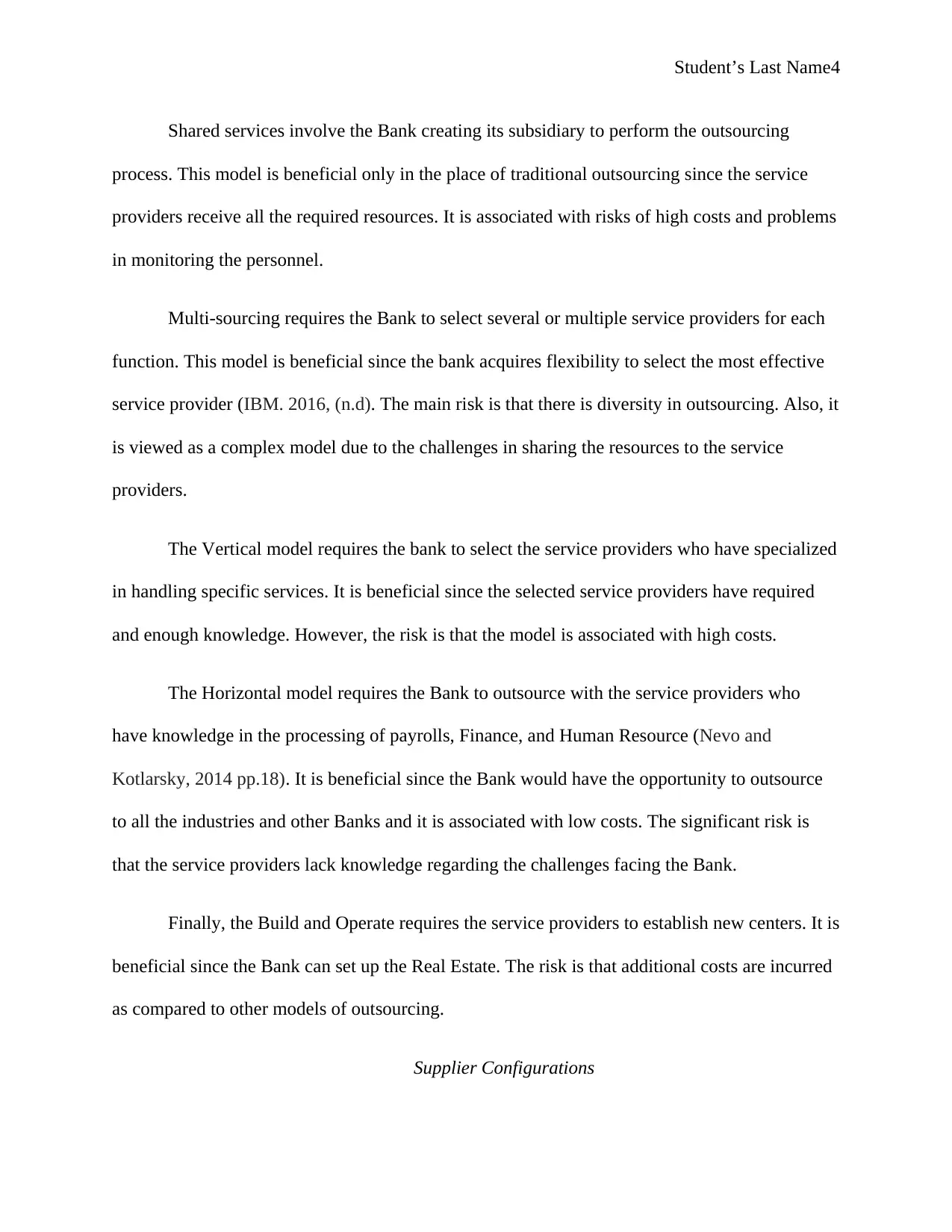
Student’s Last Name4
Shared services involve the Bank creating its subsidiary to perform the outsourcing
process. This model is beneficial only in the place of traditional outsourcing since the service
providers receive all the required resources. It is associated with risks of high costs and problems
in monitoring the personnel.
Multi-sourcing requires the Bank to select several or multiple service providers for each
function. This model is beneficial since the bank acquires flexibility to select the most effective
service provider (IBM. 2016, (n.d). The main risk is that there is diversity in outsourcing. Also, it
is viewed as a complex model due to the challenges in sharing the resources to the service
providers.
The Vertical model requires the bank to select the service providers who have specialized
in handling specific services. It is beneficial since the selected service providers have required
and enough knowledge. However, the risk is that the model is associated with high costs.
The Horizontal model requires the Bank to outsource with the service providers who
have knowledge in the processing of payrolls, Finance, and Human Resource (Nevo and
Kotlarsky, 2014 pp.18). It is beneficial since the Bank would have the opportunity to outsource
to all the industries and other Banks and it is associated with low costs. The significant risk is
that the service providers lack knowledge regarding the challenges facing the Bank.
Finally, the Build and Operate requires the service providers to establish new centers. It is
beneficial since the Bank can set up the Real Estate. The risk is that additional costs are incurred
as compared to other models of outsourcing.
Supplier Configurations
Shared services involve the Bank creating its subsidiary to perform the outsourcing
process. This model is beneficial only in the place of traditional outsourcing since the service
providers receive all the required resources. It is associated with risks of high costs and problems
in monitoring the personnel.
Multi-sourcing requires the Bank to select several or multiple service providers for each
function. This model is beneficial since the bank acquires flexibility to select the most effective
service provider (IBM. 2016, (n.d). The main risk is that there is diversity in outsourcing. Also, it
is viewed as a complex model due to the challenges in sharing the resources to the service
providers.
The Vertical model requires the bank to select the service providers who have specialized
in handling specific services. It is beneficial since the selected service providers have required
and enough knowledge. However, the risk is that the model is associated with high costs.
The Horizontal model requires the Bank to outsource with the service providers who
have knowledge in the processing of payrolls, Finance, and Human Resource (Nevo and
Kotlarsky, 2014 pp.18). It is beneficial since the Bank would have the opportunity to outsource
to all the industries and other Banks and it is associated with low costs. The significant risk is
that the service providers lack knowledge regarding the challenges facing the Bank.
Finally, the Build and Operate requires the service providers to establish new centers. It is
beneficial since the Bank can set up the Real Estate. The risk is that additional costs are incurred
as compared to other models of outsourcing.
Supplier Configurations
Paraphrase This Document
Need a fresh take? Get an instant paraphrase of this document with our AI Paraphraser
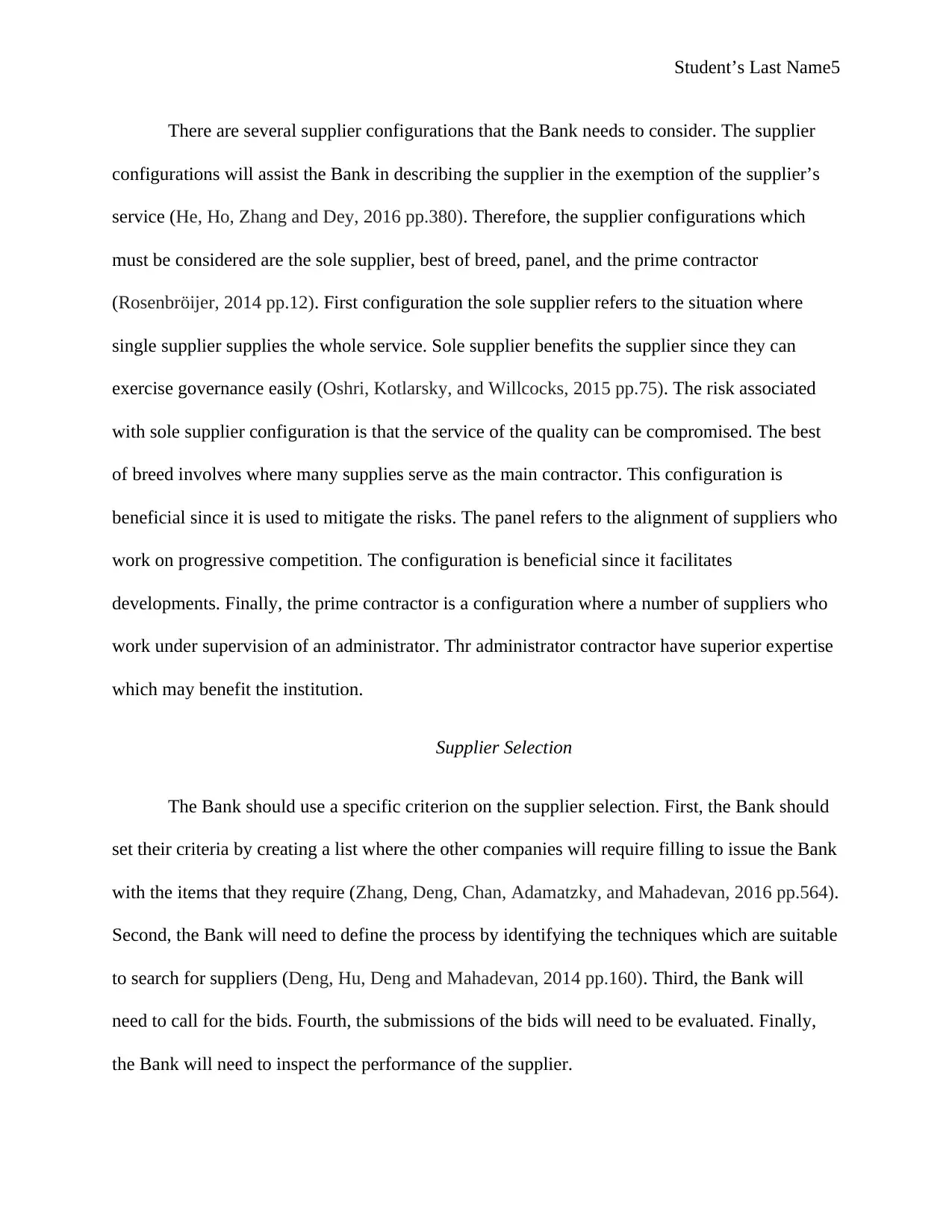
Student’s Last Name5
There are several supplier configurations that the Bank needs to consider. The supplier
configurations will assist the Bank in describing the supplier in the exemption of the supplier’s
service (He, Ho, Zhang and Dey, 2016 pp.380). Therefore, the supplier configurations which
must be considered are the sole supplier, best of breed, panel, and the prime contractor
(Rosenbröijer, 2014 pp.12). First configuration the sole supplier refers to the situation where
single supplier supplies the whole service. Sole supplier benefits the supplier since they can
exercise governance easily (Oshri, Kotlarsky, and Willcocks, 2015 pp.75). The risk associated
with sole supplier configuration is that the service of the quality can be compromised. The best
of breed involves where many supplies serve as the main contractor. This configuration is
beneficial since it is used to mitigate the risks. The panel refers to the alignment of suppliers who
work on progressive competition. The configuration is beneficial since it facilitates
developments. Finally, the prime contractor is a configuration where a number of suppliers who
work under supervision of an administrator. Thr administrator contractor have superior expertise
which may benefit the institution.
Supplier Selection
The Bank should use a specific criterion on the supplier selection. First, the Bank should
set their criteria by creating a list where the other companies will require filling to issue the Bank
with the items that they require (Zhang, Deng, Chan, Adamatzky, and Mahadevan, 2016 pp.564).
Second, the Bank will need to define the process by identifying the techniques which are suitable
to search for suppliers (Deng, Hu, Deng and Mahadevan, 2014 pp.160). Third, the Bank will
need to call for the bids. Fourth, the submissions of the bids will need to be evaluated. Finally,
the Bank will need to inspect the performance of the supplier.
There are several supplier configurations that the Bank needs to consider. The supplier
configurations will assist the Bank in describing the supplier in the exemption of the supplier’s
service (He, Ho, Zhang and Dey, 2016 pp.380). Therefore, the supplier configurations which
must be considered are the sole supplier, best of breed, panel, and the prime contractor
(Rosenbröijer, 2014 pp.12). First configuration the sole supplier refers to the situation where
single supplier supplies the whole service. Sole supplier benefits the supplier since they can
exercise governance easily (Oshri, Kotlarsky, and Willcocks, 2015 pp.75). The risk associated
with sole supplier configuration is that the service of the quality can be compromised. The best
of breed involves where many supplies serve as the main contractor. This configuration is
beneficial since it is used to mitigate the risks. The panel refers to the alignment of suppliers who
work on progressive competition. The configuration is beneficial since it facilitates
developments. Finally, the prime contractor is a configuration where a number of suppliers who
work under supervision of an administrator. Thr administrator contractor have superior expertise
which may benefit the institution.
Supplier Selection
The Bank should use a specific criterion on the supplier selection. First, the Bank should
set their criteria by creating a list where the other companies will require filling to issue the Bank
with the items that they require (Zhang, Deng, Chan, Adamatzky, and Mahadevan, 2016 pp.564).
Second, the Bank will need to define the process by identifying the techniques which are suitable
to search for suppliers (Deng, Hu, Deng and Mahadevan, 2014 pp.160). Third, the Bank will
need to call for the bids. Fourth, the submissions of the bids will need to be evaluated. Finally,
the Bank will need to inspect the performance of the supplier.

Student’s Last Name6
Alternative Types of Contracts
The Bank needs to consider the alternative types of contracts. For instance, a fixed-price
contract should be considered in the case where price is considered as the only key factor. In
such a case, the expertise of the contractor as well as the price is viewed as the selection criteria.
A fee or cost, target price, and the project management contract should be considered in the case
where the Bank desires to attain flexibility (Sako, 2014 pp.10). In addition, it is sensible if the
Bank will employ these contracts in implementing the speedy projects. This is because the
contracts provide an opportunity where the constructions and designs can overlap (Fandel and
Trockel, 2016 pp.8). Finally, an MM’s project management contract which is cost based should
be considered in the case where the bank desires to attain flexibility while the price is a
significant factor.
Skills that Needs to be retained
The Bank needs to retain four skills which are entrepreneurial skills and the analytical
thinking, the knowledge on the industry, a focus which is visionary, and resilience in a
surrounding where there is high pressure due to various reasons. First, the entrepreneurial and the
analytical thinking skills will help the bank in the management of risks (Grund and Thommes,
2015 pp.12). The banking experts succeed in managing risks due to the analytical skills. For
instance, the bank consultants should always be sharp to accommodate new concepts (Passera,
Haapio and Curtotti, 2014 pp.11). Second, the Bank needs the skill of industrial knowledge to
offer products and services of high quality and which are also impressive. In addition, the
industrial knowledge keeps the individuals inspired and they can employ all the existing
knowledge in regard to banking such as the economy, finance, and the banking regulation. Third,
Alternative Types of Contracts
The Bank needs to consider the alternative types of contracts. For instance, a fixed-price
contract should be considered in the case where price is considered as the only key factor. In
such a case, the expertise of the contractor as well as the price is viewed as the selection criteria.
A fee or cost, target price, and the project management contract should be considered in the case
where the Bank desires to attain flexibility (Sako, 2014 pp.10). In addition, it is sensible if the
Bank will employ these contracts in implementing the speedy projects. This is because the
contracts provide an opportunity where the constructions and designs can overlap (Fandel and
Trockel, 2016 pp.8). Finally, an MM’s project management contract which is cost based should
be considered in the case where the bank desires to attain flexibility while the price is a
significant factor.
Skills that Needs to be retained
The Bank needs to retain four skills which are entrepreneurial skills and the analytical
thinking, the knowledge on the industry, a focus which is visionary, and resilience in a
surrounding where there is high pressure due to various reasons. First, the entrepreneurial and the
analytical thinking skills will help the bank in the management of risks (Grund and Thommes,
2015 pp.12). The banking experts succeed in managing risks due to the analytical skills. For
instance, the bank consultants should always be sharp to accommodate new concepts (Passera,
Haapio and Curtotti, 2014 pp.11). Second, the Bank needs the skill of industrial knowledge to
offer products and services of high quality and which are also impressive. In addition, the
industrial knowledge keeps the individuals inspired and they can employ all the existing
knowledge in regard to banking such as the economy, finance, and the banking regulation. Third,
⊘ This is a preview!⊘
Do you want full access?
Subscribe today to unlock all pages.

Trusted by 1+ million students worldwide
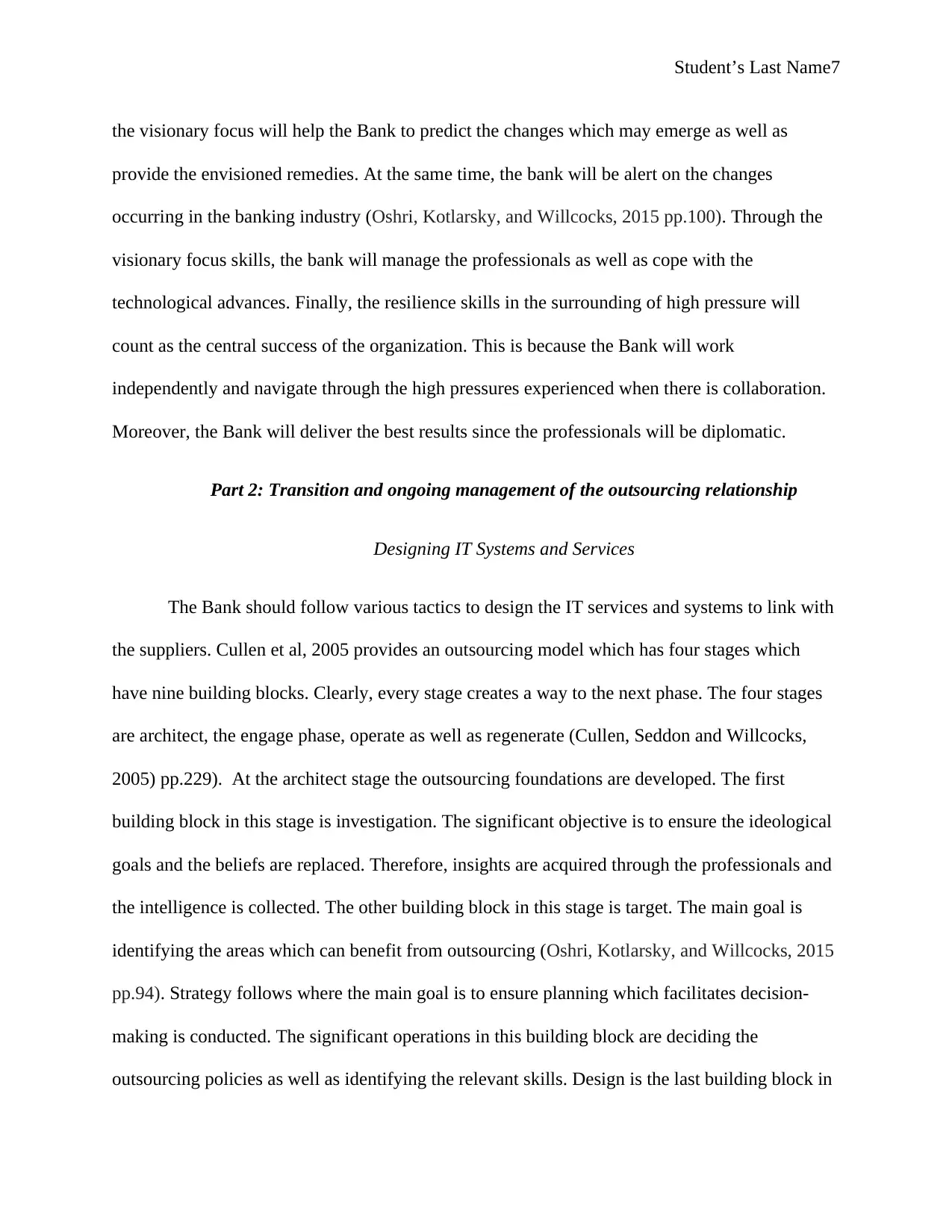
Student’s Last Name7
the visionary focus will help the Bank to predict the changes which may emerge as well as
provide the envisioned remedies. At the same time, the bank will be alert on the changes
occurring in the banking industry (Oshri, Kotlarsky, and Willcocks, 2015 pp.100). Through the
visionary focus skills, the bank will manage the professionals as well as cope with the
technological advances. Finally, the resilience skills in the surrounding of high pressure will
count as the central success of the organization. This is because the Bank will work
independently and navigate through the high pressures experienced when there is collaboration.
Moreover, the Bank will deliver the best results since the professionals will be diplomatic.
Part 2: Transition and ongoing management of the outsourcing relationship
Designing IT Systems and Services
The Bank should follow various tactics to design the IT services and systems to link with
the suppliers. Cullen et al, 2005 provides an outsourcing model which has four stages which
have nine building blocks. Clearly, every stage creates a way to the next phase. The four stages
are architect, the engage phase, operate as well as regenerate (Cullen, Seddon and Willcocks,
2005) pp.229). At the architect stage the outsourcing foundations are developed. The first
building block in this stage is investigation. The significant objective is to ensure the ideological
goals and the beliefs are replaced. Therefore, insights are acquired through the professionals and
the intelligence is collected. The other building block in this stage is target. The main goal is
identifying the areas which can benefit from outsourcing (Oshri, Kotlarsky, and Willcocks, 2015
pp.94). Strategy follows where the main goal is to ensure planning which facilitates decision-
making is conducted. The significant operations in this building block are deciding the
outsourcing policies as well as identifying the relevant skills. Design is the last building block in
the visionary focus will help the Bank to predict the changes which may emerge as well as
provide the envisioned remedies. At the same time, the bank will be alert on the changes
occurring in the banking industry (Oshri, Kotlarsky, and Willcocks, 2015 pp.100). Through the
visionary focus skills, the bank will manage the professionals as well as cope with the
technological advances. Finally, the resilience skills in the surrounding of high pressure will
count as the central success of the organization. This is because the Bank will work
independently and navigate through the high pressures experienced when there is collaboration.
Moreover, the Bank will deliver the best results since the professionals will be diplomatic.
Part 2: Transition and ongoing management of the outsourcing relationship
Designing IT Systems and Services
The Bank should follow various tactics to design the IT services and systems to link with
the suppliers. Cullen et al, 2005 provides an outsourcing model which has four stages which
have nine building blocks. Clearly, every stage creates a way to the next phase. The four stages
are architect, the engage phase, operate as well as regenerate (Cullen, Seddon and Willcocks,
2005) pp.229). At the architect stage the outsourcing foundations are developed. The first
building block in this stage is investigation. The significant objective is to ensure the ideological
goals and the beliefs are replaced. Therefore, insights are acquired through the professionals and
the intelligence is collected. The other building block in this stage is target. The main goal is
identifying the areas which can benefit from outsourcing (Oshri, Kotlarsky, and Willcocks, 2015
pp.94). Strategy follows where the main goal is to ensure planning which facilitates decision-
making is conducted. The significant operations in this building block are deciding the
outsourcing policies as well as identifying the relevant skills. Design is the last building block in
Paraphrase This Document
Need a fresh take? Get an instant paraphrase of this document with our AI Paraphraser
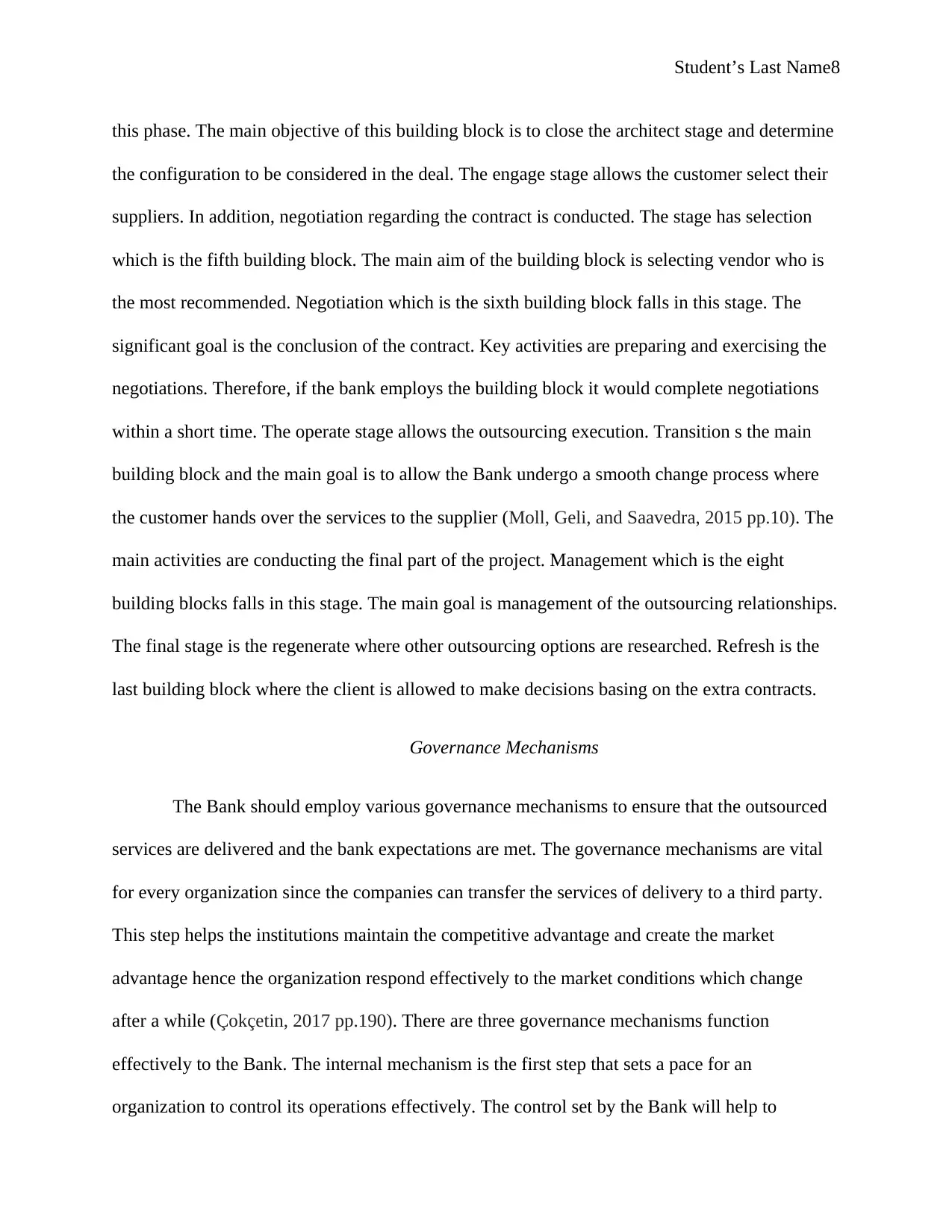
Student’s Last Name8
this phase. The main objective of this building block is to close the architect stage and determine
the configuration to be considered in the deal. The engage stage allows the customer select their
suppliers. In addition, negotiation regarding the contract is conducted. The stage has selection
which is the fifth building block. The main aim of the building block is selecting vendor who is
the most recommended. Negotiation which is the sixth building block falls in this stage. The
significant goal is the conclusion of the contract. Key activities are preparing and exercising the
negotiations. Therefore, if the bank employs the building block it would complete negotiations
within a short time. The operate stage allows the outsourcing execution. Transition s the main
building block and the main goal is to allow the Bank undergo a smooth change process where
the customer hands over the services to the supplier (Moll, Geli, and Saavedra, 2015 pp.10). The
main activities are conducting the final part of the project. Management which is the eight
building blocks falls in this stage. The main goal is management of the outsourcing relationships.
The final stage is the regenerate where other outsourcing options are researched. Refresh is the
last building block where the client is allowed to make decisions basing on the extra contracts.
Governance Mechanisms
The Bank should employ various governance mechanisms to ensure that the outsourced
services are delivered and the bank expectations are met. The governance mechanisms are vital
for every organization since the companies can transfer the services of delivery to a third party.
This step helps the institutions maintain the competitive advantage and create the market
advantage hence the organization respond effectively to the market conditions which change
after a while (Çokçetin, 2017 pp.190). There are three governance mechanisms function
effectively to the Bank. The internal mechanism is the first step that sets a pace for an
organization to control its operations effectively. The control set by the Bank will help to
this phase. The main objective of this building block is to close the architect stage and determine
the configuration to be considered in the deal. The engage stage allows the customer select their
suppliers. In addition, negotiation regarding the contract is conducted. The stage has selection
which is the fifth building block. The main aim of the building block is selecting vendor who is
the most recommended. Negotiation which is the sixth building block falls in this stage. The
significant goal is the conclusion of the contract. Key activities are preparing and exercising the
negotiations. Therefore, if the bank employs the building block it would complete negotiations
within a short time. The operate stage allows the outsourcing execution. Transition s the main
building block and the main goal is to allow the Bank undergo a smooth change process where
the customer hands over the services to the supplier (Moll, Geli, and Saavedra, 2015 pp.10). The
main activities are conducting the final part of the project. Management which is the eight
building blocks falls in this stage. The main goal is management of the outsourcing relationships.
The final stage is the regenerate where other outsourcing options are researched. Refresh is the
last building block where the client is allowed to make decisions basing on the extra contracts.
Governance Mechanisms
The Bank should employ various governance mechanisms to ensure that the outsourced
services are delivered and the bank expectations are met. The governance mechanisms are vital
for every organization since the companies can transfer the services of delivery to a third party.
This step helps the institutions maintain the competitive advantage and create the market
advantage hence the organization respond effectively to the market conditions which change
after a while (Çokçetin, 2017 pp.190). There are three governance mechanisms function
effectively to the Bank. The internal mechanism is the first step that sets a pace for an
organization to control its operations effectively. The control set by the Bank will help to
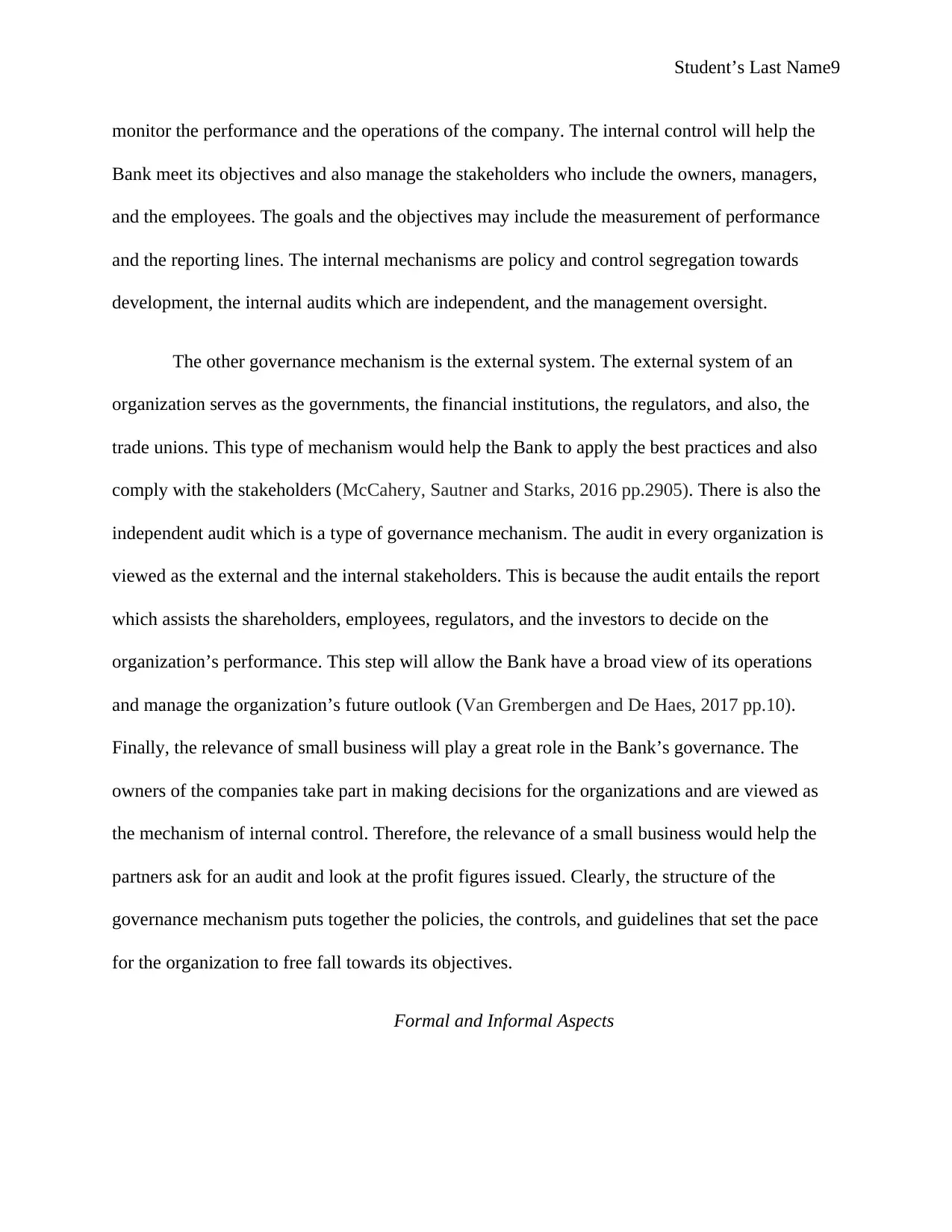
Student’s Last Name9
monitor the performance and the operations of the company. The internal control will help the
Bank meet its objectives and also manage the stakeholders who include the owners, managers,
and the employees. The goals and the objectives may include the measurement of performance
and the reporting lines. The internal mechanisms are policy and control segregation towards
development, the internal audits which are independent, and the management oversight.
The other governance mechanism is the external system. The external system of an
organization serves as the governments, the financial institutions, the regulators, and also, the
trade unions. This type of mechanism would help the Bank to apply the best practices and also
comply with the stakeholders (McCahery, Sautner and Starks, 2016 pp.2905). There is also the
independent audit which is a type of governance mechanism. The audit in every organization is
viewed as the external and the internal stakeholders. This is because the audit entails the report
which assists the shareholders, employees, regulators, and the investors to decide on the
organization’s performance. This step will allow the Bank have a broad view of its operations
and manage the organization’s future outlook (Van Grembergen and De Haes, 2017 pp.10).
Finally, the relevance of small business will play a great role in the Bank’s governance. The
owners of the companies take part in making decisions for the organizations and are viewed as
the mechanism of internal control. Therefore, the relevance of a small business would help the
partners ask for an audit and look at the profit figures issued. Clearly, the structure of the
governance mechanism puts together the policies, the controls, and guidelines that set the pace
for the organization to free fall towards its objectives.
Formal and Informal Aspects
monitor the performance and the operations of the company. The internal control will help the
Bank meet its objectives and also manage the stakeholders who include the owners, managers,
and the employees. The goals and the objectives may include the measurement of performance
and the reporting lines. The internal mechanisms are policy and control segregation towards
development, the internal audits which are independent, and the management oversight.
The other governance mechanism is the external system. The external system of an
organization serves as the governments, the financial institutions, the regulators, and also, the
trade unions. This type of mechanism would help the Bank to apply the best practices and also
comply with the stakeholders (McCahery, Sautner and Starks, 2016 pp.2905). There is also the
independent audit which is a type of governance mechanism. The audit in every organization is
viewed as the external and the internal stakeholders. This is because the audit entails the report
which assists the shareholders, employees, regulators, and the investors to decide on the
organization’s performance. This step will allow the Bank have a broad view of its operations
and manage the organization’s future outlook (Van Grembergen and De Haes, 2017 pp.10).
Finally, the relevance of small business will play a great role in the Bank’s governance. The
owners of the companies take part in making decisions for the organizations and are viewed as
the mechanism of internal control. Therefore, the relevance of a small business would help the
partners ask for an audit and look at the profit figures issued. Clearly, the structure of the
governance mechanism puts together the policies, the controls, and guidelines that set the pace
for the organization to free fall towards its objectives.
Formal and Informal Aspects
⊘ This is a preview!⊘
Do you want full access?
Subscribe today to unlock all pages.

Trusted by 1+ million students worldwide
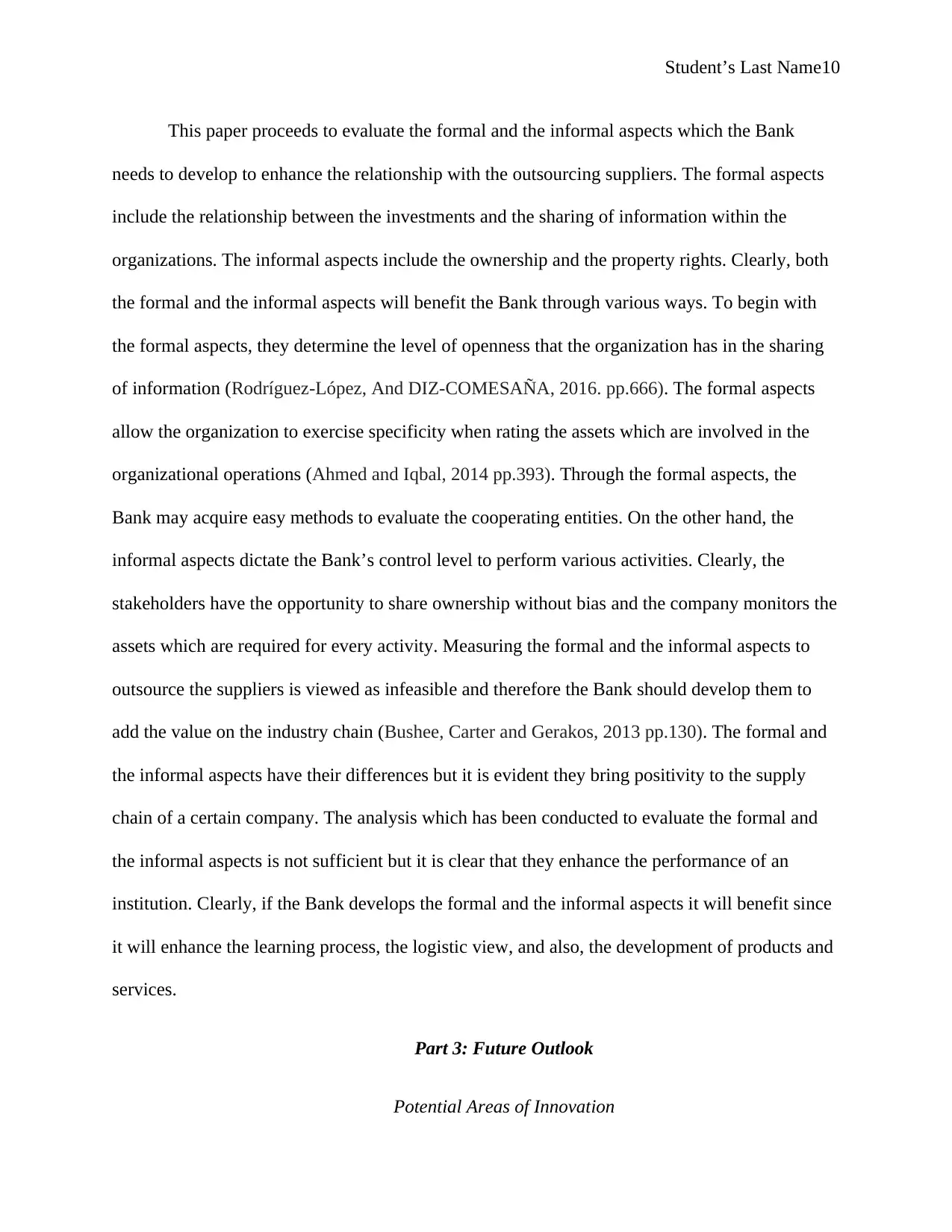
Student’s Last Name10
This paper proceeds to evaluate the formal and the informal aspects which the Bank
needs to develop to enhance the relationship with the outsourcing suppliers. The formal aspects
include the relationship between the investments and the sharing of information within the
organizations. The informal aspects include the ownership and the property rights. Clearly, both
the formal and the informal aspects will benefit the Bank through various ways. To begin with
the formal aspects, they determine the level of openness that the organization has in the sharing
of information (Rodríguez-López, And DIZ-COMESAÑA, 2016. pp.666). The formal aspects
allow the organization to exercise specificity when rating the assets which are involved in the
organizational operations (Ahmed and Iqbal, 2014 pp.393). Through the formal aspects, the
Bank may acquire easy methods to evaluate the cooperating entities. On the other hand, the
informal aspects dictate the Bank’s control level to perform various activities. Clearly, the
stakeholders have the opportunity to share ownership without bias and the company monitors the
assets which are required for every activity. Measuring the formal and the informal aspects to
outsource the suppliers is viewed as infeasible and therefore the Bank should develop them to
add the value on the industry chain (Bushee, Carter and Gerakos, 2013 pp.130). The formal and
the informal aspects have their differences but it is evident they bring positivity to the supply
chain of a certain company. The analysis which has been conducted to evaluate the formal and
the informal aspects is not sufficient but it is clear that they enhance the performance of an
institution. Clearly, if the Bank develops the formal and the informal aspects it will benefit since
it will enhance the learning process, the logistic view, and also, the development of products and
services.
Part 3: Future Outlook
Potential Areas of Innovation
This paper proceeds to evaluate the formal and the informal aspects which the Bank
needs to develop to enhance the relationship with the outsourcing suppliers. The formal aspects
include the relationship between the investments and the sharing of information within the
organizations. The informal aspects include the ownership and the property rights. Clearly, both
the formal and the informal aspects will benefit the Bank through various ways. To begin with
the formal aspects, they determine the level of openness that the organization has in the sharing
of information (Rodríguez-López, And DIZ-COMESAÑA, 2016. pp.666). The formal aspects
allow the organization to exercise specificity when rating the assets which are involved in the
organizational operations (Ahmed and Iqbal, 2014 pp.393). Through the formal aspects, the
Bank may acquire easy methods to evaluate the cooperating entities. On the other hand, the
informal aspects dictate the Bank’s control level to perform various activities. Clearly, the
stakeholders have the opportunity to share ownership without bias and the company monitors the
assets which are required for every activity. Measuring the formal and the informal aspects to
outsource the suppliers is viewed as infeasible and therefore the Bank should develop them to
add the value on the industry chain (Bushee, Carter and Gerakos, 2013 pp.130). The formal and
the informal aspects have their differences but it is evident they bring positivity to the supply
chain of a certain company. The analysis which has been conducted to evaluate the formal and
the informal aspects is not sufficient but it is clear that they enhance the performance of an
institution. Clearly, if the Bank develops the formal and the informal aspects it will benefit since
it will enhance the learning process, the logistic view, and also, the development of products and
services.
Part 3: Future Outlook
Potential Areas of Innovation
Paraphrase This Document
Need a fresh take? Get an instant paraphrase of this document with our AI Paraphraser

Student’s Last Name11
It is evident that the Banks experience transformation since there are various changes
which occur in the potential areas of innovation which include the consumer behaviors, needs,
knowledge, and competition. These changes arise due to the technological advances,
liberalization, and globalization which prevail. Therefore, the Bank will need to embrace a
culture which focuses on the management of customer relationship (Achimba, Ongonga,
Nyarondia, Amos and Okwara, 2014 pp.14). Clearly, organizations cannot afford to ignore the
factors in the potential areas of innovation if they want to operate to the optimum level. The
Bank should be aware that the competitors are experiencing similar changes and therefore they
need to alter their plans. Therefore, the Bank needs to enhance the efficiency and the
effectiveness of their systems to cope with the competition (Oshri, Kotlarsky, and Willcocks,
2015 pp.200). For this reason, technology is viewed as a vital tool in the management and the
creation of the relations between the organizations and the clients in this paper. Moreover,
technology facilitates better interactions within a company. The Bank should also ensure there is
transparency in the management of the customers. The Bank needs to arrange the objectives,
mission, goals, and vision to ensure that the customer satisfaction is achieved. The Bank should
ensure the clients receive good services which will make them loyal and hence growth will be
facilitated within the organization. Through, technology, speed, and accuracy will be achieved
and also the Bank will offer quality services and products.
Challenges
However, the Bank may face various challenges in the potential areas which need
innovation in the future as outlined in this paper. First, the Bank may be hindered from making
money as they expect due to less return on the investments that the shareholders require. The
Bank may not meet the consumer expectations in the future due to the pressure that the
It is evident that the Banks experience transformation since there are various changes
which occur in the potential areas of innovation which include the consumer behaviors, needs,
knowledge, and competition. These changes arise due to the technological advances,
liberalization, and globalization which prevail. Therefore, the Bank will need to embrace a
culture which focuses on the management of customer relationship (Achimba, Ongonga,
Nyarondia, Amos and Okwara, 2014 pp.14). Clearly, organizations cannot afford to ignore the
factors in the potential areas of innovation if they want to operate to the optimum level. The
Bank should be aware that the competitors are experiencing similar changes and therefore they
need to alter their plans. Therefore, the Bank needs to enhance the efficiency and the
effectiveness of their systems to cope with the competition (Oshri, Kotlarsky, and Willcocks,
2015 pp.200). For this reason, technology is viewed as a vital tool in the management and the
creation of the relations between the organizations and the clients in this paper. Moreover,
technology facilitates better interactions within a company. The Bank should also ensure there is
transparency in the management of the customers. The Bank needs to arrange the objectives,
mission, goals, and vision to ensure that the customer satisfaction is achieved. The Bank should
ensure the clients receive good services which will make them loyal and hence growth will be
facilitated within the organization. Through, technology, speed, and accuracy will be achieved
and also the Bank will offer quality services and products.
Challenges
However, the Bank may face various challenges in the potential areas which need
innovation in the future as outlined in this paper. First, the Bank may be hindered from making
money as they expect due to less return on the investments that the shareholders require. The
Bank may not meet the consumer expectations in the future due to the pressure that the
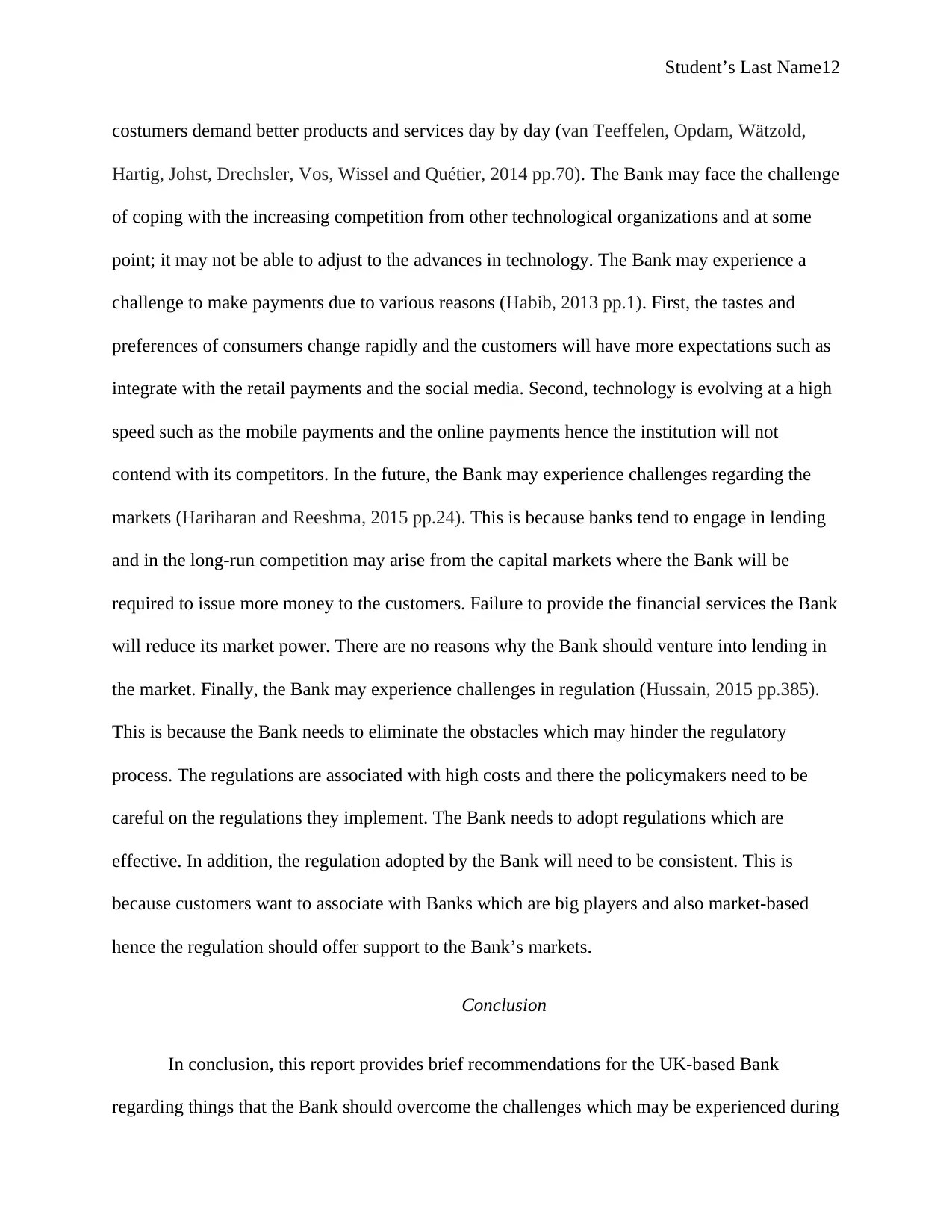
Student’s Last Name12
costumers demand better products and services day by day (van Teeffelen, Opdam, Wätzold,
Hartig, Johst, Drechsler, Vos, Wissel and Quétier, 2014 pp.70). The Bank may face the challenge
of coping with the increasing competition from other technological organizations and at some
point; it may not be able to adjust to the advances in technology. The Bank may experience a
challenge to make payments due to various reasons (Habib, 2013 pp.1). First, the tastes and
preferences of consumers change rapidly and the customers will have more expectations such as
integrate with the retail payments and the social media. Second, technology is evolving at a high
speed such as the mobile payments and the online payments hence the institution will not
contend with its competitors. In the future, the Bank may experience challenges regarding the
markets (Hariharan and Reeshma, 2015 pp.24). This is because banks tend to engage in lending
and in the long-run competition may arise from the capital markets where the Bank will be
required to issue more money to the customers. Failure to provide the financial services the Bank
will reduce its market power. There are no reasons why the Bank should venture into lending in
the market. Finally, the Bank may experience challenges in regulation (Hussain, 2015 pp.385).
This is because the Bank needs to eliminate the obstacles which may hinder the regulatory
process. The regulations are associated with high costs and there the policymakers need to be
careful on the regulations they implement. The Bank needs to adopt regulations which are
effective. In addition, the regulation adopted by the Bank will need to be consistent. This is
because customers want to associate with Banks which are big players and also market-based
hence the regulation should offer support to the Bank’s markets.
Conclusion
In conclusion, this report provides brief recommendations for the UK-based Bank
regarding things that the Bank should overcome the challenges which may be experienced during
costumers demand better products and services day by day (van Teeffelen, Opdam, Wätzold,
Hartig, Johst, Drechsler, Vos, Wissel and Quétier, 2014 pp.70). The Bank may face the challenge
of coping with the increasing competition from other technological organizations and at some
point; it may not be able to adjust to the advances in technology. The Bank may experience a
challenge to make payments due to various reasons (Habib, 2013 pp.1). First, the tastes and
preferences of consumers change rapidly and the customers will have more expectations such as
integrate with the retail payments and the social media. Second, technology is evolving at a high
speed such as the mobile payments and the online payments hence the institution will not
contend with its competitors. In the future, the Bank may experience challenges regarding the
markets (Hariharan and Reeshma, 2015 pp.24). This is because banks tend to engage in lending
and in the long-run competition may arise from the capital markets where the Bank will be
required to issue more money to the customers. Failure to provide the financial services the Bank
will reduce its market power. There are no reasons why the Bank should venture into lending in
the market. Finally, the Bank may experience challenges in regulation (Hussain, 2015 pp.385).
This is because the Bank needs to eliminate the obstacles which may hinder the regulatory
process. The regulations are associated with high costs and there the policymakers need to be
careful on the regulations they implement. The Bank needs to adopt regulations which are
effective. In addition, the regulation adopted by the Bank will need to be consistent. This is
because customers want to associate with Banks which are big players and also market-based
hence the regulation should offer support to the Bank’s markets.
Conclusion
In conclusion, this report provides brief recommendations for the UK-based Bank
regarding things that the Bank should overcome the challenges which may be experienced during
⊘ This is a preview!⊘
Do you want full access?
Subscribe today to unlock all pages.

Trusted by 1+ million students worldwide
1 out of 16
Related Documents
Your All-in-One AI-Powered Toolkit for Academic Success.
+13062052269
info@desklib.com
Available 24*7 on WhatsApp / Email
![[object Object]](/_next/static/media/star-bottom.7253800d.svg)
Unlock your academic potential
Copyright © 2020–2025 A2Z Services. All Rights Reserved. Developed and managed by ZUCOL.



